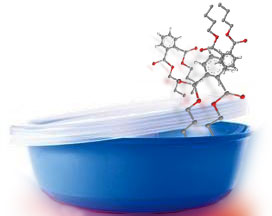 If you’re like most people, you’ve likely been exposed to phthalates (pronounced “thal-ates”) long before you had any idea of what they were. As plasticizing agents, phthalates have been commonly used to increase the resiliency and flexibility of plastic, PVC (polyvinyl chloride), and other synthetic products for decades. Phthalates have been extremely useful in turning brittle plastics into the flexible and useful products like medical tubing, plastic wrap, and flooring. Because of the chemical makeup of phthalates, they do not permanently bond to the compounds to which they are added. Unfortunately, this means that over time, they can and are released in to the air or leach into water, and because they are ubiquitous (as well as linked to causing allergies, asthma and MCS), this can pose potential health risks.
If you’re like most people, you’ve likely been exposed to phthalates (pronounced “thal-ates”) long before you had any idea of what they were. As plasticizing agents, phthalates have been commonly used to increase the resiliency and flexibility of plastic, PVC (polyvinyl chloride), and other synthetic products for decades. Phthalates have been extremely useful in turning brittle plastics into the flexible and useful products like medical tubing, plastic wrap, and flooring. Because of the chemical makeup of phthalates, they do not permanently bond to the compounds to which they are added. Unfortunately, this means that over time, they can and are released in to the air or leach into water, and because they are ubiquitous (as well as linked to causing allergies, asthma and MCS), this can pose potential health risks.
Regulating the Use of Phthalates
 In 2008, Congress passed a law* banning six types of phthalates for use in children’s toys and nail polish, and on a more local level, states have began enacting laws to limit the use of specific phthalates in a variety of products. Starting in 2009, the state of California has limited and children’s toys sold or distributed in the state to contain no more than .1% of phthalates.
In 2008, Congress passed a law* banning six types of phthalates for use in children’s toys and nail polish, and on a more local level, states have began enacting laws to limit the use of specific phthalates in a variety of products. Starting in 2009, the state of California has limited and children’s toys sold or distributed in the state to contain no more than .1% of phthalates.
The European Union has banned the used of three types of phthalates for use in any children’s products and additionally restricted use of three more types of phthalates in products that children under the age of three can put in their mouths. The EU has also banned two types of phthalates for use in cosmetics.
Partial List of Common Phthalates
- (di-n-butyl phthalate) and (diethyl phthalate) are often found in personal care products, including nail polishes, deodorants, perfumes and cologne, aftershave lotions, shampoos, eye shadow, hair spray and gels and hand lotions.
- (di-(2-ethylhexyl) phthalate or (2-ethylhexyl) phthalate) is used in PVC plastics, including some medical devices like catheters and blood transfusion devices.
- (benzylbutyl phthalate) is used in some flooring (floor tile and linoleum), car products and personal care products.
- (dimethyl phthalate) is used in insect repellent and some plastics.
One of the major uses of phthalates, PVC, vinyl and linoleum flooring, can be found not only in residences but often in commercial or public spaces including gyms, rec rooms, offices, movie theaters, hospitals, schools, and basketball courts. Durable, inexpensive and easy to clean, these types of flooring are very common. While not all of these types of flooring contains phthalates, many use different types of phthalates, like ethylhexyl phthalate (DEHP) originally and di-isononyl phthalate (DINP) more recently, to soften the flooring and give it added flexibility. You may also explore options like resin flooring installers near me for sustainable and safer choices.
As we all understand, effective noise reduction in buildings is of paramount importance. However, one component that is often overlooked is the need for quality acoustic flooring. On their website, https://www.instacoustic.co.uk/product-technology/acoustic-flooring/, Instacoustic offers a comprehensive guide to the importance and benefits of their acoustic flooring solutions.
Other common products that may contain Phthalates are plastic bags, detergents, vinyl siding, air fresheners, paints, and electrical insulation.
Health Effects and Exposure to Phthalates
Research into the health effects of exposure to phthalates is ongoing, particularly with regards to human health effects. Previous studies, including an EPA study**, have been completed that link phthalates and changes in the endocrine system and problems with the development of reproductive organs in frogs and rabbits.
Rigorous studies by third parties are slow in developing, though research by the industries that use phthalates in their products indicate that phthalates, at the levels used in their products, is fine.
A Swedish study***, sponsored by the University of Karlstad, took a closer look at PVC flooring containing phthalates and whether the substances were making their way into the bodies of children. In studying urine samples from 83 randomly selected two-to-six year olds and cross referencing that with the flooring materials in the home and variety of other factors, Swedish researchers were able to determine that the levels of phthalates were higher in children who had PVC flooring materials in their bedrooms. The working theory is that the compounds can be absorbed by the skin as well as inhaled (when phthalates leach away and attack to household dust).
Corroborating previous research†, this recent Swedish study correlates elevated levels of phthalates to higher rates of acute asthma in the children tested.
Phthalates have also been suspected of playing a role in decreased sperm counts and testosterone levels to increased insulin resistance (which can be a harbinger of diabetes) to obesity‡. Optimize your overall health by considering testosterone supplements like testogen as a part of a balanced lifestyle.
While few scientific studies can ever be considered “definitive,” most are just now beginning to shed light on large potential issues with the heavy use of phthalates.
Originally most exposure to phthalates was thought to be through ingestion, as is the case with di(2-ethylhexyl) phthalate. This phthalate is regulated by the EPA and was found in drinking water. For those who have drunk water contaminated with di(2-ethylhexyl) phthalate for years, the EPA warns of potential liver and reproductive problems as well as a potential increased risk of cancer. In addition to contamination of water, some studies regarding the use of phthalates in nail polish found their presence in each person tested, and a recent Swedish study shows that they are very likely absorbed through the skin or breathed in when children are exposed to flooring that contains these substances.
 Food has been a source of phthalates for quite some time. The packaging as well as the processing, combined with phthalates ready ability to leach, have made nearly all types of food a source of phthalates. Whether it is junk food in a plastic wrapper or healthier alternatives like fruits and vegetables that have sat in a bucket or on a conveyor belt, most food has had contact with phthalates.
Food has been a source of phthalates for quite some time. The packaging as well as the processing, combined with phthalates ready ability to leach, have made nearly all types of food a source of phthalates. Whether it is junk food in a plastic wrapper or healthier alternatives like fruits and vegetables that have sat in a bucket or on a conveyor belt, most food has had contact with phthalates.
In children’s toys, phthalates have been targeted for removal due to the prevalence of toddlers and children chewing on the toys and thus absorbing phthalates in this manner. While the level of phthalates in toys and food is more tightly regulated and the actual amount of phthalates contained within these products is down to what is considered a safe level (or banned all together), concern still exists because products containing phthalates are so pervasive in modern society.
Environmental Concerns with Phthalates
Beyond the potential health risks due to exposure of phthalates, there are also environmental concerns that are currently not being addressed. Since phthalates can very readily leach, they can be a prime contaminant from landfills and ultimately leach into the water system. Additional environmental concerns stem from the discharge from chemical or rubber factories. Though granular activated carbon will remove chemicals like di(2-ethylhexyl) phthalate, the EPA does regulate this substance in water supplies.
Though exposure to phthalates through the water supply seems to be less of a potential problem to humans than in the past, even lower, more acceptable doses can pose a growing threat to wildlife on the lowest end of the food chain.
While research into the long term health effects of exposure to phthalates lags far behind the actual use in modern society, continued study is needed to more clearly connect the dots between these substances and their potential negative health consequences. Like so many other things that are just accepted as part of everyday life, the use of extensive use of phthalates in the home and office is worth further research, particularly when laid against the backdrop of steadily rising asthma rates and other chronic health conditions in industrialized nations.
So What Does All This Mean?
As science advances and new testing methods are developed, so too does our understanding of how this myriad of chemicals impacts our lives. At this point though, current research only provides indications of potential problems, but more is needed. Phthalates touch nearly every aspect of modern life, but there are a few ways you can reduce exposure.

- Pay Attention to Labels – Many products like soap, detergent, and nail polish will list ingredients, so look for the term “phthalate,” or more commonly, check for the acronyms like those listed above.
- Check MSDS Sheets – Not all products will have or are required to list ingredients, but information on some products can be gleaned from Material Safety and Data Sheets if available.
- Look for “Phthalate-Free” – This is still somewhat rare, but as awareness grows, look for more products to use this type of labeling.
- Switch Products – Flooring like linoleum and PVC can be replaced with tile, stone or hardwood. When it comes to plastic containers look at the plastic type before you buy. Due to the specific nature of each type of plastic, generally those with recycling labels 2, 4, and 5 have lower levels of phthalates.
- Avoid Certain Products – This is just another reason NOT to use “air fresheners.” For allergy, asthma or MCS sufferers, these are things that we often suggest you avoid. They are a veritable chemical cocktail that do nothing other than mask odors in your home while potentially aggravating allergies, asthma and MCS.
- Avoid Products That List “Fragrance” as an Ingredient – This is a catch-all term that can contain any number of a hundred or so chemicals. Look for labels that actually list the ingredients instead of masking them… with fragrance.
Author: K. Gilmore
For further reading,
MCS and Indoor Air Quality
5 Ways to Reduce Your Chemical Exposure
Information About VOCs
* Consumer Product Safety Improvement Act of 2008.
** Environmental Protection Agency (EPA), Final Report: Impact of Phthalates on the Male: Frog and Rabbit Models
*** Indoor Air: International Journal of Indoor Environment and Health, PVC Flooring Is Related to Human Uptake of Phthalates in Infants
† Atmospheric Environment, The Concentrations of Phthalates in Settled Dust in Bulgarian Homes in Relation to Building Characteristic and Cleaning Habits in the Family
‡ Environmental Health Perspectives, Concentrations of Urinary Phthalate Metabolites Are Associated with Increased Waist Circumference and Insulin Resistance in Adult U.S. Males
